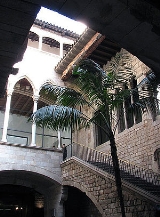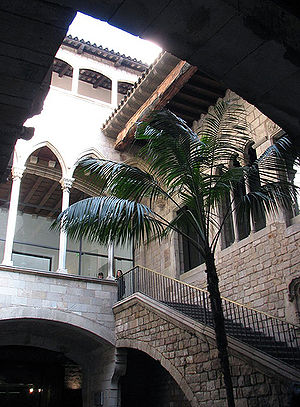
Museu Picasso
Encyclopedia

Barcelona
Barcelona is the second largest city in Spain after Madrid, and the capital of Catalonia, with a population of 1,621,537 within its administrative limits on a land area of...
, Spain
Spain
Spain , officially the Kingdom of Spain languages]] under the European Charter for Regional or Minority Languages. In each of these, Spain's official name is as follows:;;;;;;), is a country and member state of the European Union located in southwestern Europe on the Iberian Peninsula...
, has one of the most extensive collections of artworks by the 20th century Spanish artist Pablo Picasso
Pablo Picasso
Pablo Diego José Francisco de Paula Juan Nepomuceno María de los Remedios Cipriano de la Santísima Trinidad Ruiz y Picasso known as Pablo Ruiz Picasso was a Spanish expatriate painter, sculptor, printmaker, ceramicist, and stage designer, one of the greatest and most influential artists of the...
. This is one of the most popular and most visited museums in Barcelona. The museum is housed in five adjoining medieval palaces in Barcelona's La Ribera
La Ribera
La Ribera is one of the areas of the quarter of Sant Pere, Santa Caterina i la Ribera of Ciutat Vella of Barcelona.Many of the buildings date from late Medieval times. It was a well-to-do quarter during 13th-15th centuries, when it really was by the sea shore, and the area that today is named...
.
The original idea for the museum came from Picasso’s lifelong friend, Jaume Sabartés. Picasso had given Sabartés great many paintings, drawings and prints during the course of their friendship. Originally Sabartés had planned to set up a museum based on his collection in Málaga
Málaga
Málaga is a city and a municipality in the Autonomous Community of Andalusia, Spain. With a population of 568,507 in 2010, it is the second most populous city of Andalusia and the sixth largest in Spain. This is the southernmost large city in Europe...
, Picasso’s birthplace. It was Picasso himself who suggested that Barcelona would be more appropriate, given his long standing connections with the city.
The museum first opened in 1963 and the original collection was made up of Sabartés donation (574 works), the items that Picasso had previously given to the city of Barcelona, those that had previously been in the possession of the city’s museum of modern art plus other gifts from Picasso’s friends and collectors.
After Sabartés death in 1968, Picasso himself donated a large number of items to the museum, including approximately 1000 items of his early work which his family had been keeping for him ever since the time he first settled in France. This included school books, academic pieces and paintings from Picasso's Blue Period. There are now more than 3,500 works making up the permanent collection of the museum.
Picasso arrived in the city in 1894, when his father, an art teacher, had found work teaching in the city art school. Highlights of the collection include two of his first major works, The First Communion (1896), and Science and Charity (1897). In particular, the Museu Picasso reveals Picasso's relationship with the city of Barcelona, a relationship that was shaped in his youth and adolescence, and continued until his death.
Collection
The museum contains the following collections, organized by date:- MálagaMálagaMálaga is a city and a municipality in the Autonomous Community of Andalusia, Spain. With a population of 568,507 in 2010, it is the second most populous city of Andalusia and the sixth largest in Spain. This is the southernmost large city in Europe...
- A CoruñaA CoruñaA Coruña or La Coruña is a city and municipality of Galicia, Spain. It is the second-largest city in the autonomous community and seventeenth overall in the country...
- BarcelonaBarcelonaBarcelona is the second largest city in Spain after Madrid, and the capital of Catalonia, with a population of 1,621,537 within its administrative limits on a land area of...
- MálagaMálagaMálaga is a city and a municipality in the Autonomous Community of Andalusia, Spain. With a population of 568,507 in 2010, it is the second most populous city of Andalusia and the sixth largest in Spain. This is the southernmost large city in Europe...
: summers of 1896 and 1897 - MadridMadridMadrid is the capital and largest city of Spain. The population of the city is roughly 3.3 million and the entire population of the Madrid metropolitan area is calculated to be 6.271 million. It is the third largest city in the European Union, after London and Berlin, and its metropolitan...
- Horta de Sant JoanHorta de Sant JoanHorta de Sant Joan is a municipality in the comarca of la Terra Alta in Catalonia, Spain.This town is located in a picturesque spot on a hill in view of the landscape of the northwestern foothills of the Ports de Tortosa-Beseit...
- Barcelona: 1899–1900
- ParisParisParis is the capital and largest city in France, situated on the river Seine, in northern France, at the heart of the Île-de-France region...
: 1900–1901 - The Blue Period
- The Rose Period
- Barcelona: 1917
- 1917–1957
- Las MeninasLas Meninas (Picasso)Las Meninas is a serie of 58 paintings that Pablo Picasso painted in 1957 by performing a comprehensive analysis, reinterpreting and recreating several times Las Meninas by Diego Velázquez. The suite is fully preserved at the Museu Picasso in Barcelona and is the only complete series of the artist...
- Picasso engraver
- Picasso ceramist
Exhibitions
The Museu Picasso frequently hosts special exhibitions presenting artworks by Picasso and other artists. From time to time, the museum also organizes seminarSeminar
Seminar is, generally, a form of academic instruction, either at an academic institution or offered by a commercial or professional organization. It has the function of bringing together small groups for recurring meetings, focusing each time on some particular subject, in which everyone present is...
s and lectures on subjects related to Picasso or on museological issues of interest given by specialists from throughout the world.

